In the fifth industrial revolution, respect for human labour and a sustainable approach to production are returning to centre stage. A visit to Alstom’s long-standing site in Savigliano (Cuneo, Italy) gave us the opportunity to witness these values being rooted in an advanced industrial context, where installing a new coating system entailed finding a plant engineering partner that was not only reliable but also capable of understanding and embracing the same principles. This article describes the new solid partnership established between Alstom, a global leader in smart and sustainable mobility, and Eurotherm, which has been designing and building coating plants since 1958.
The development of the railway network has played and continues to play a crucial role in the economic growth of many countries. The railways – whose origins can be traced back to the famous trials run in Rainhill, England, to find the most suitable locomotive to travel along the Liverpool-Manchester line – contributed to the development of the first industrial revolution, marking a fundamental turning point in the history of humankind: they favoured the mechanisation of land transport, bringing the peoples and commercial and industrial activities in the areas they touched closer together.
Nowadays, the most advanced factories producing rolling stock and railway components and servicing them are centres of excellence in line with the parameters of Industry 4.0, the fourth industrial revolution, based on the concept of fully automated and interconnected production, and even already projected towards the fifth industrial revolution through a focus on worker comfort and low-carbon systems. One example of this is Alstom, a global leader in smart and sustainable mobility, which has been manufacturing trains for 170 years, signalling systems for 90 years, and traction systems for 60 years. Its new investment plan revolves around a strong commitment to economic growth, technological innovation, and social and environmental sustainability.
Michele Viale, the Managing Director of Alstom Italy and the President and CEO of Alstom Ferroviaria, stated in a press release in September 2024: “Alstom continues to be a strategic partner for the sustainable development of rail transport and the Italian economy. With a contribution to the GDP of more than € 1.019 billion generated in the past two years and supporting more than 14,000 jobs, Alstom is an accelerator of employment and professional development for thousands of people in Italy. In an Italian mobility system characterised by great dynamism and constant growth, supported by the PNRR and the IPCEI Fund, Alstom continues to invest and is pleased to announce a new investment plan of more than € 63 million [for 2024-2026] that will give further boost to our business, with an important impact on the entire Italian railway sector."
The first impact document published by Alstom in Italy also emphasised its intention to achieve environmental neutrality by 2050. “The company has set ambitious targets to reduce CO2 emissions, aiming to achieve ‘net zero’ by 2050, with intermediate milestones for 2025 and 2030. Alstom is taking an eco-design approach to minimise the environmental impact of its products by optimising the use of materials, reducing pollution in production and delivery, and improving energy efficiency with actions such as insulating buildings, monitoring temperature, installing LEDs, improving lighting control systems, and installing photovoltaic panels in sites. The company also continues with a strong commitment to waste reduction, and as of today already 98% of the waste produced is recycled.”
All of Alstom’s nine sites in Italy, which employ more than 4,000 workers, will benefit from the new investment plan and will be the subject of the company’s eco-sustainable commitment. We visited its centre of excellence in Savigliano (Cuneo) to report on how these developments also resulted in the design and installation of a new liquid coating plant from Eurotherm Spa (Volpiano, Turin, Italy), a company specialising precisely in surface treatment systems for train bodies and components.
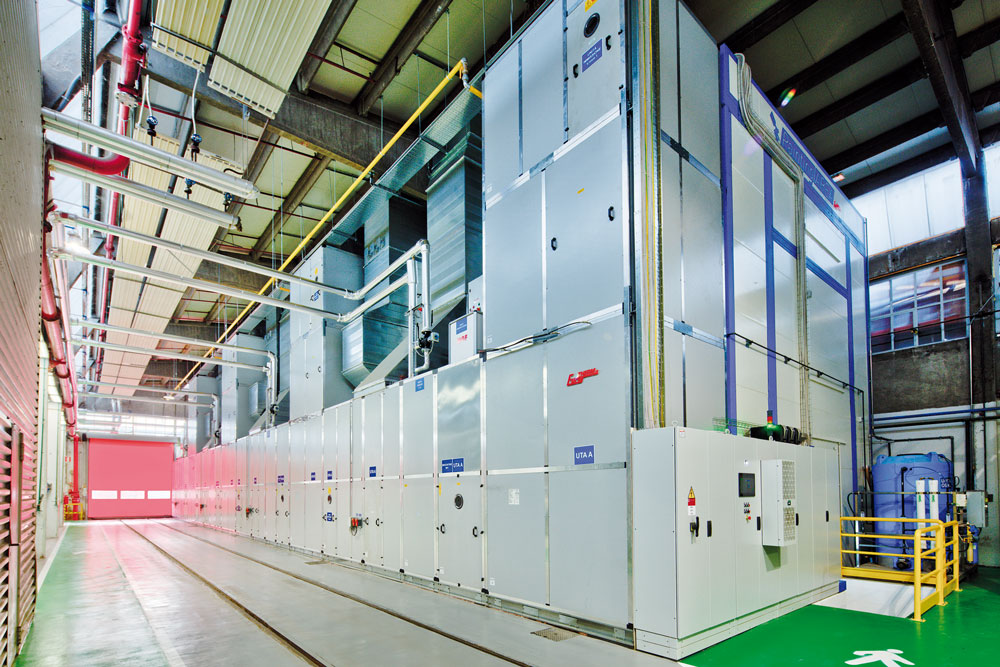 The latest coating plant installed at the Savigliano site, designed and built by Eurotherm. © Eurotherm
The latest coating plant installed at the Savigliano site, designed and built by Eurotherm. © EurothermAlstom’s history in Italy
Alstom, a global leader in smart and sustainable mobility active in the construction of trains, signalling systems, and railway infrastructure, owes its name to “Alsthom”, the result of the contraction of the words Alsace and Thomson, as it was created from the merger in 1928 of a part of SACM (Société Alsacienne de Constructions Mécaniques), a locomotive construction specialist based in Mulhouse (France), with CFTH (Compagnie française Thomson-Houston), a Franco-American company specialising in electric traction equipment. The saga of the resulting company intertwined with Italy’s industrial history through various acquisitions, including that of Fiat Ferroviaria (Savigliano), the manufacturer of the Pendolino train and the holder of the relevant patent, in 2000; another significant step was the acquisition in January 2021 of Bombardier Transportation Italy, whose site in Vado Ligure (Savona, Italy) was dedicated to producing railway locomotives alongside the Savigliano site.
The Savigliano site
The Savigliano site, which covers an area of 323,000 m2, is one of the most important design and production hubs in the Italian railway industry, together with another global competence centre in Bologna specialising in railway signalling and traffic supervision systems. “Founded in 1853 in the same period as the construction of the first stretch of track from Turin to Savigliano,” says Rolling Stock Director Davide Viale while tracing the history of the site, “this site is Alstom’s worldwide production hub for the regional trains of the Coradia Stream family. In the 1960s, it produced the first diesel and electric rail cruisers and high-speed trains of the Avelia Stream family – some of them were tilting trains, such as the Pendolino, a unique example of engineering excellence at the time, designed right in this site in the early 1970s and inspired by the pendulum movement to negotiate curves at a higher speed without increasing the uncompensated transverse acceleration, thus balancing the centrifugal acceleration perceived by travellers.”
Savigliano is also one of the Alstom maintenance division’s sites: although this mainly operates directly in the depots of railway operators throughout Italy, its bogie maintenance and inspection services are carried out in a dedicated department within this site. The factory houses both production lines and all the required resources for the company’s design, industrialisation, validation, supply chain, manufacturing engineering, production, and planning activities. “In 20 years,” Davide Viale adds, “this factory has produced 500 Pendolino trains sold in 12 countries, from Italy to Finland and from the UK to Russia, and, in collaboration with other Italian sites, over 600 trains of the Coradia/Minuetto family, now in service in Italy from Trentino to Sicily. It is an example of an Industry 4.0-oriented site – with a state-of-the-art 3D virtual reality room enabling our engineers to design trains for easier maintenance – already projected towards Industry 5.0.”
Coating as a strategic resource
As Davide Viale further emphasises, “In response to the increased workload at the Savigliano site, we launched an investment plan about two years ago to double the production capacity of several departments, including the coating one. We therefore needed to integrate a new booth into our coating department that would represent the state of the art in the railway sector. We chose Eurotherm, whose name is well known in our sector, because it could meet all our standards and respond effectively to all our requests, which were the result of years of experience in the surface treatment of train bodies – related to quality, sustainability (we have been applying water-based products for almost 20 years), ergonomics, and safety (which Alstom aims to guarantee to all its workers). Last but not least, Eurotherm provided us with a turnkey system, also taking charge of the masonry work.”
A turnkey, in-ground coating plant
Eurotherm’s booth is fully pressurised and equipped with two mobile scaffolds with a maximum load capacity of 250 kg each, and it has a length of 35 m, a width of 7 m, and a height of 8 m (7 + 1 m underground to allow the operator to paint underbodies). “These dimensions,” says Paolo Tesio, Site Facilities Engineer at Alstom, “were specifically requested to ensure that all parts of both our regional and high-speed train bodies could be properly coated. Eurotherm’s staff could not only design and install the booth but also take care of the masonry work, thus presenting us with a ‘turnkey’ project.”
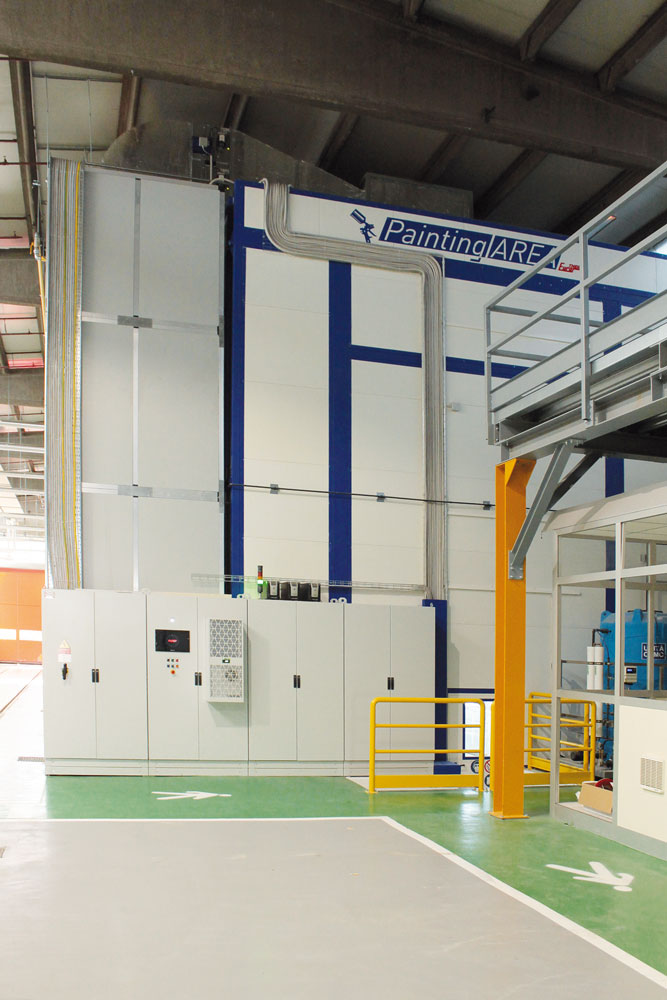 One of the project’s biggest challenges was the limited space within the factory hall. © ipcm
One of the project’s biggest challenges was the limited space within the factory hall. © ipcm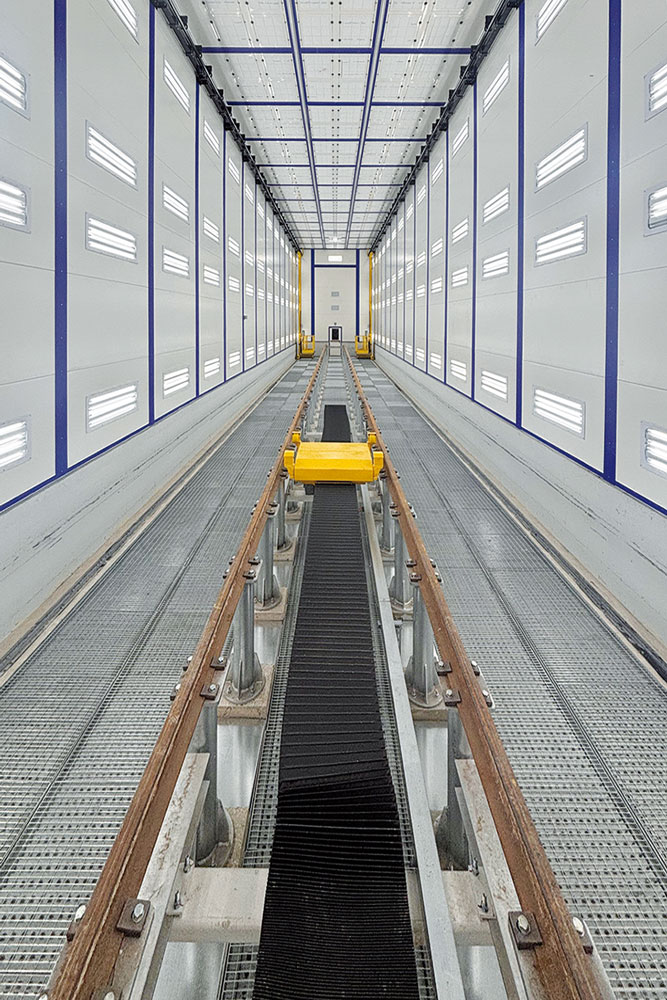 The booth is 35 m long, 7 m wide, and 8 m high. © Eurotherm
The booth is 35 m long, 7 m wide, and 8 m high. © Eurotherm“The building operations were among the most complex phases in the entire project,” notes Davide Quartana, project manager at Eurotherm. “Designing a new in-ground plant in an existing building is never simple, especially in a structure like the one in Savigliano, with some dated halls. Moreover, on top of its uncommon length, the coating system had to be placed, on the one hand, close to the external wall and, on the other hand, in a position so as not to hinder the passage of carriages. The masonry work we undertook included the insertion of micropiles to reinforce the existing plinths and prevent landslides in the structure above. After three months, the construction work – begun on 5 April 2024 and completed on 5 July with the laying of the tracks – could be considered complete, and we were able to focus on building the booth.”
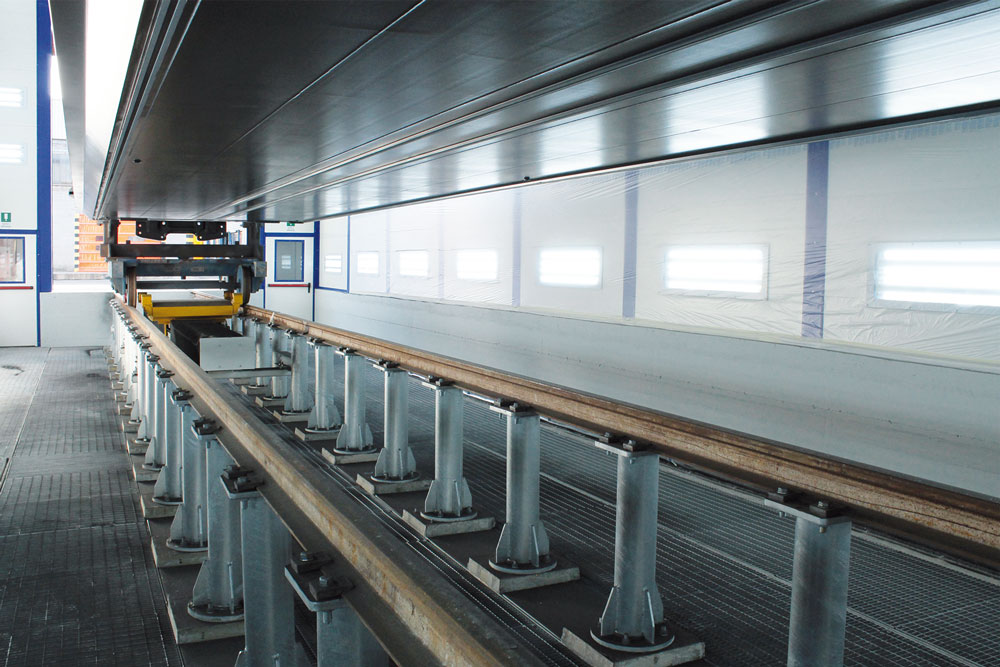 The system has an in-ground booth reaching one metre below floor level. © Eurotherm
The system has an in-ground booth reaching one metre below floor level. © EurothermThe technical details that determined the choice of the plant manufacturer
Another aspect that factored into the railway giant’s preference for Eurotherm was its technical team’s attention to Alstom’s specific requirements. “We have been handling our coating operations for many years now,” Tesio says, “thus achieving a surface treatment-related know-how that has enabled us to draft precise specifications for our new system. Eurotherm’s offer met our requests in terms of both the excavation and construction phases and the technical solutions included. Its technological capacity also proved crucial to our need for greater ergonomics for our workers. For example, we requested gas burners with air stream technology because we consider it the most stable and reliable option based on our experience and that of our operators – it avoids non-ergonomic situations that can compromise productivity – as well as a sensible choice in terms of energy savings.”
“With combustion,” Quartana explains, “about 30% of the calorific value is lost. The air stream solution meets Alstom’s need for energy efficiency, as confirmed by the baking temperature reached through air recirculation: only 10% of the air fed into the booth comes from outside, whereas the rest is recovered from inside. This way, the set temperature is also reached very quickly.”
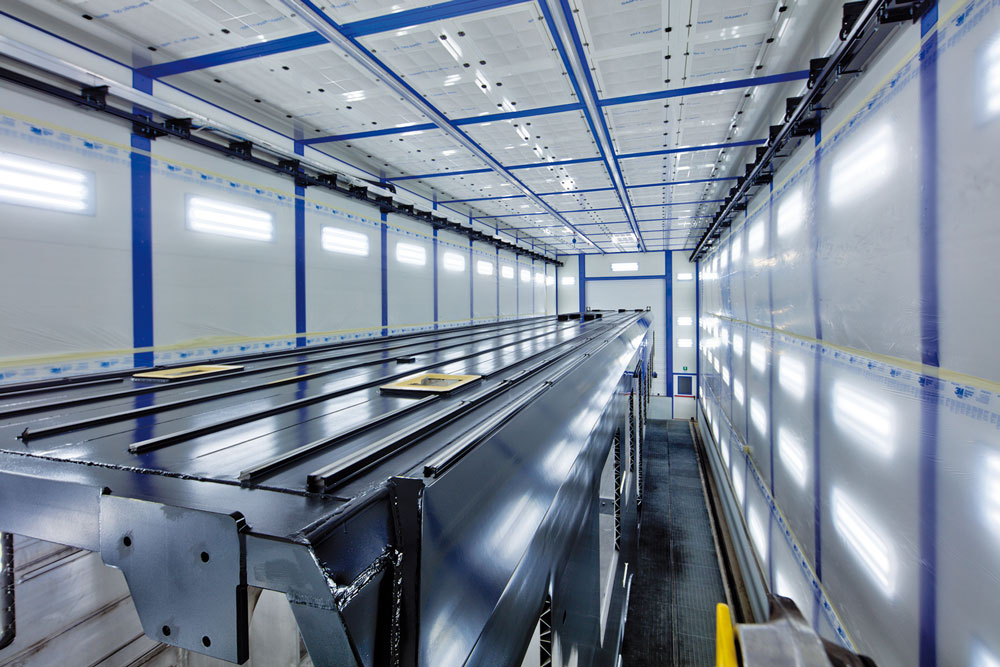 The plant is equipped with a fully vertical airflow filtration system, with air inlet from above and suction and filtration from below through two dry filters. © Eurotherm
The plant is equipped with a fully vertical airflow filtration system, with air inlet from above and suction and filtration from below through two dry filters. © Eurotherm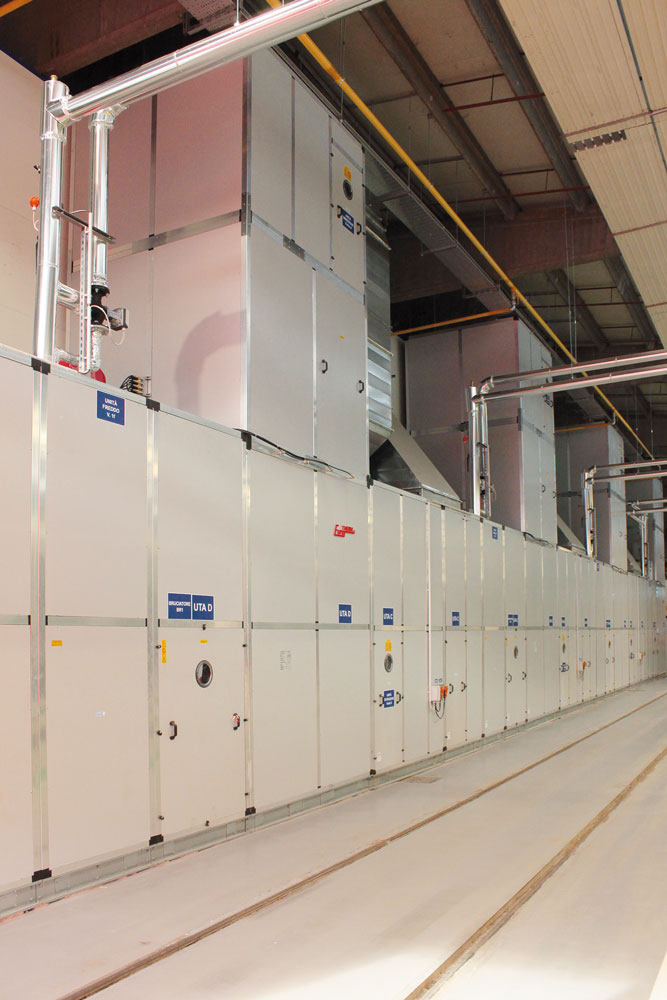 Superior filtration is provided by four AHUs, each with a capacity of 55,000 m3. © ipcm
Superior filtration is provided by four AHUs, each with a capacity of 55,000 m3. © ipcm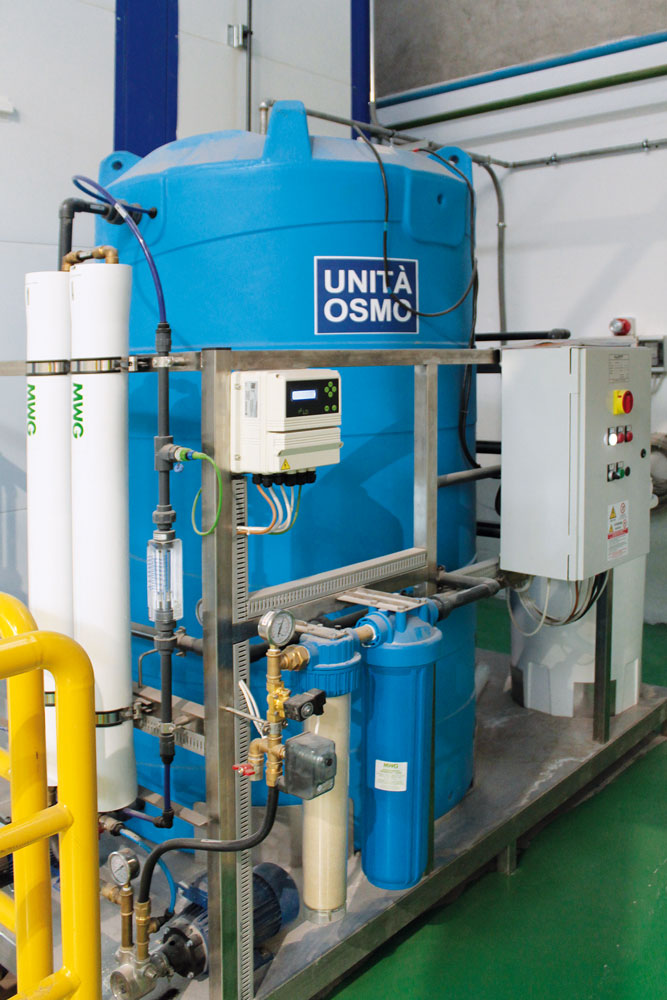 The reverse osmosis system for atomising water inside AHUs, supplied by Eurotherm. © ipcm
The reverse osmosis system for atomising water inside AHUs, supplied by Eurotherm. © ipcmThe plant has a fully vertical airflow filtration system, with air inlet from above and suction and filtration from below through two dry filters. Superior filtration is provided by four AHUs, each with a capacity of 55,000 m3 and combined with a cooling system with refrigeration units supplied by Eurotherm. In addition to the heat units fed by the gas burners, the upper part of the booth houses a humidification system and an additional moisture filtration device consisting of drop separators. The air enters the booth through a plenum space acting as the last stage of the filtration process, preventing dust from falling into the booth and affecting coating quality.
Ergonomic comfort comes first
“The booth is pressurised with the controlled humidification system using atomising nozzles, according to our humidity standards,” says Tesio. “A reverse osmosis unit also provided by Eurotherm supplies the water to be atomised in the AHUs: in our experience, using mains water could clog the nozzles due to limescale. Another of our requests concerned the inspectability of the filter sections: they all had to be easily accessible from the ground.”
Inside the booth, the two mobile scaffolds have hydraulic (and not pneumatic) movement: “Again according to our experience, this handling solution avoids jerking, lack of movement continuity, and poor repeatability of the coater’s gestures due to vibrations,” explains Fabio Di Donato, Special Process Expert at Alstom. “Inside the booth, the scaffolds move on three axes: right/left, up/down, and forward/backward. Based on that, we asked the installation team to equip the mobile scaffolds’ platforms with comfortable and ergonomic foot pedals and to position the joypad in a suitable way to avoid torso twisting.”
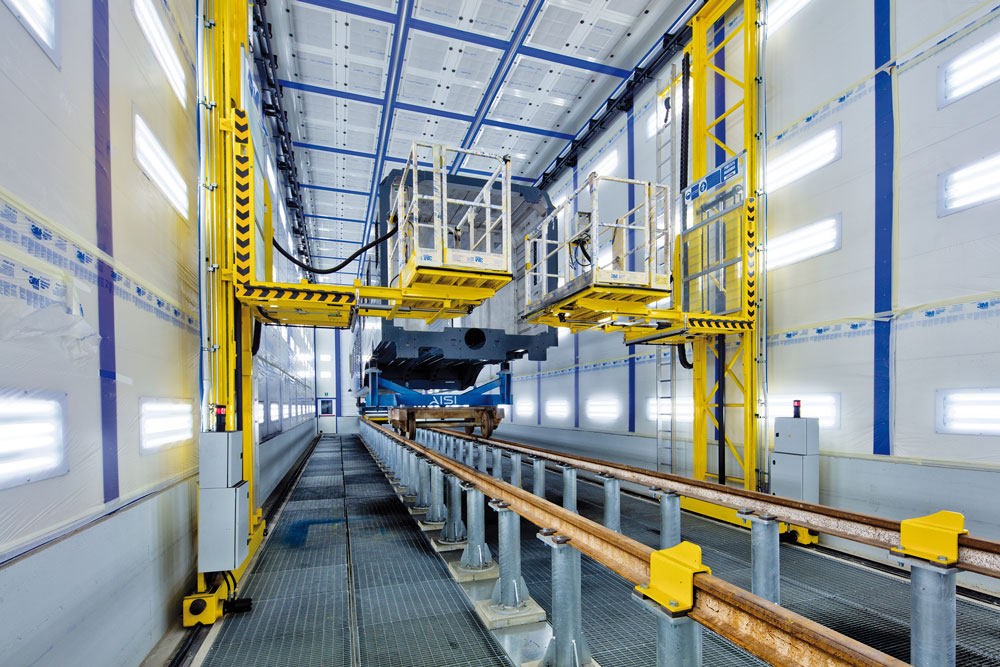 The booth is equipped with two mobile scaffolds, each with a maximum load capacity of 250 kg. © Eurotherm
The booth is equipped with two mobile scaffolds, each with a maximum load capacity of 250 kg. © EurothermEurotherm did not struggle to meet this requirement: as Quartana points out, “For years now, we have replaced pneumatic handling technology with hydraulic technology to achieve the best work ergonomics and avoid having electrical components in the booth, thus meeting ATEX standards. In addition, to guarantee the minimum preparation and application distance and comfortable movement for the coater, we extended the length of the system by one metre compared with the initial design.” Finally, the control panel is also Industry 4.0-optimised to be user-friendly and be remotely connected with Eurotherm’s support team if needed.
In its Savigliano site, Alstom is currently manufacturing new trains for customers such as Trenitalia, STA - Strutture Trasporto Alto Adige SpA, and ÖBB-Personenverkehr AG. “Our new Eurotherm system has proven fundamental for the approval of the coating applied on these vehicles’ bodies. We started the plant at the beginning of November 2024 and achieved approval in record time before Christmas. That further proved that our new booth implements state-of-the-art technology, the result of the analysis and correction of past defects and a strategic resource for Alstom’s future, also in view of the expected increases in production volumes and our growth prospects.”
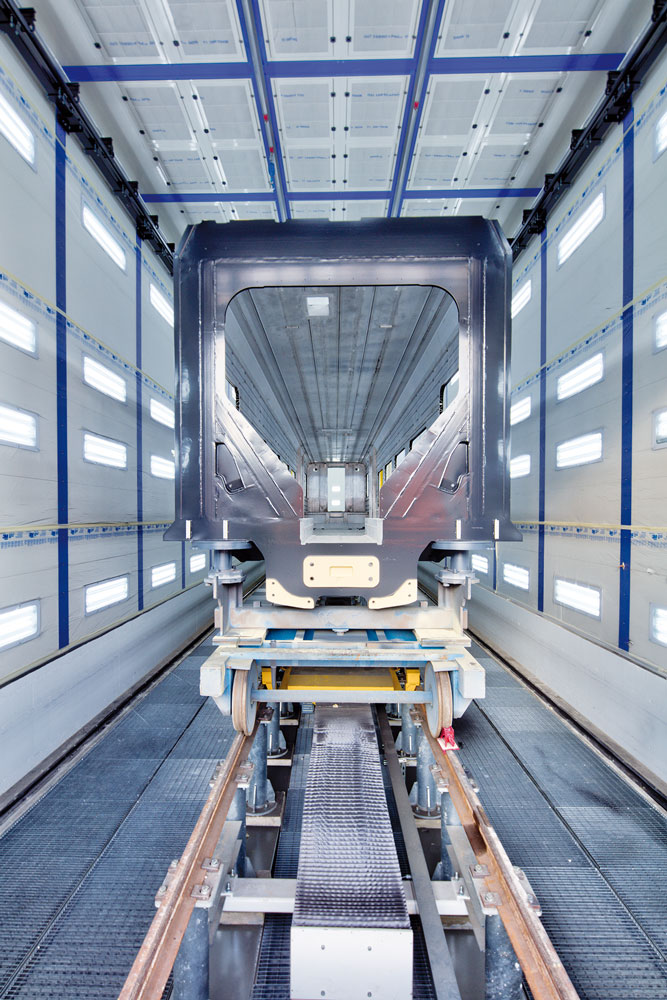 After sheet metal working, cleaning with a surfactant, and sandblasting, the train body is ready to be masked and coated. © ipcm
After sheet metal working, cleaning with a surfactant, and sandblasting, the train body is ready to be masked and coated. © ipcm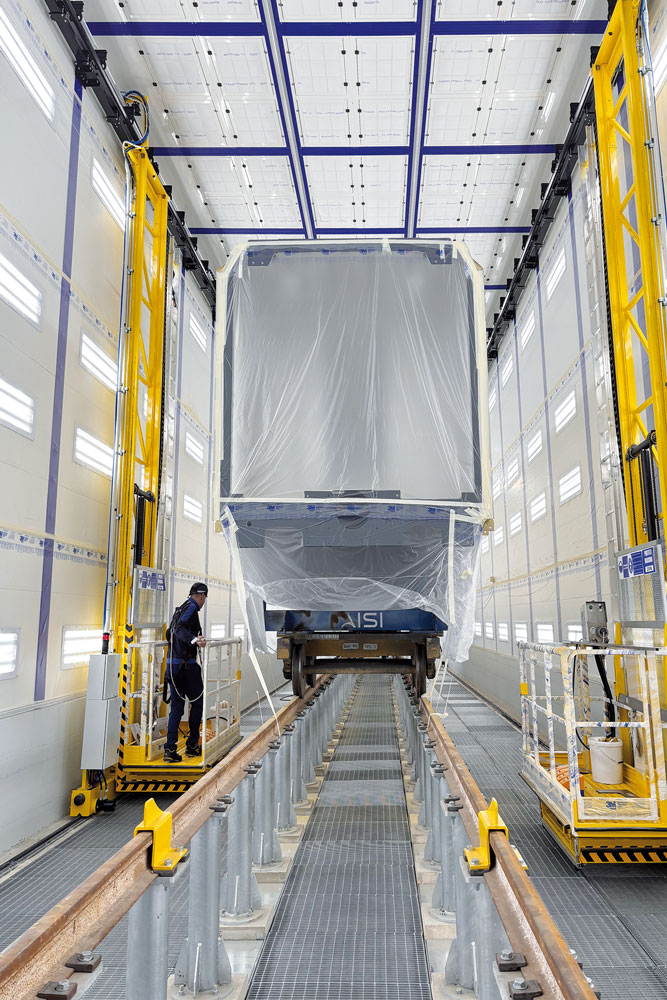 The two mobile scaffolds feature hydraulic handling technology instead of pneumatic technology to achieve the best work ergonomics and avoid having electrical components in the booth. © Eurotherm
The two mobile scaffolds feature hydraulic handling technology instead of pneumatic technology to achieve the best work ergonomics and avoid having electrical components in the booth. © EurothermAlstom’s customised coating cycles
Alstom’s coating department is organised in two workstations, one devoted to surface preparation through cleaning and sandblasting and the other to paint application. “After sheet metal working,” Di Donato illustrates, “each train body is cleaned through industrial high-pressure washers spraying a surfactant to degrease and remove oils from its aluminium surfaces. After drying, sandblasting is carried out first automatically by a robot and then manually to treat the few remaining difficult-to-reach areas. From here, the train body reaches the coating station, equipped with several booths (the last one installed being the Eurotherm one) to carry out one of the available coating cycles depending on customer needs.”
“The most flexible cycle entails the application of several layers of paint and an anti-graffiti adhesive film,” explains Federica Lenta, Special Process Manager at Alstom, “whereas in the most complex one, after the preparatory stages, several layers are applied (primer, filler, and base coat, each with its related smoothing operation) before the coloured or metallised paint. For areas with different colours and depending on each customer’s train livery, we use jigs to systematically replicate the colour scheme. The last step is the application of a clear coat to reach the required finish (gloss) degree and protect the surfaces against external agents such as abrasion, graffiti, weathering, and UV rays. For the roof and underbody, a lighter cycle is performed because they are non-visible elements of the train.”
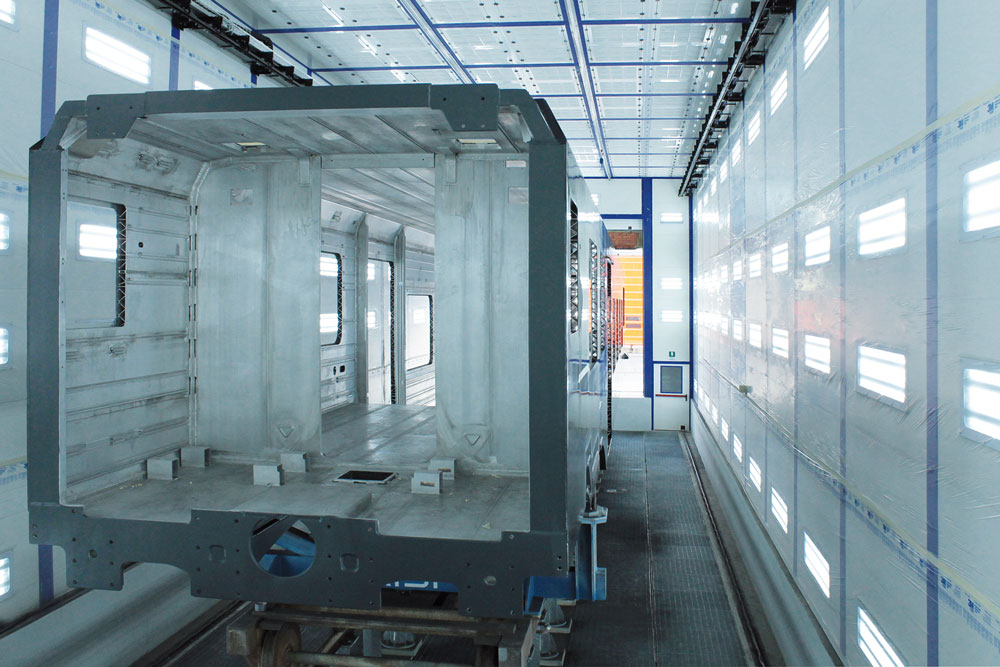 The body is subjected to masking, coating with water-based paint, flash-off, and final baking. © Eurotherm
The body is subjected to masking, coating with water-based paint, flash-off, and final baking. © Eurotherm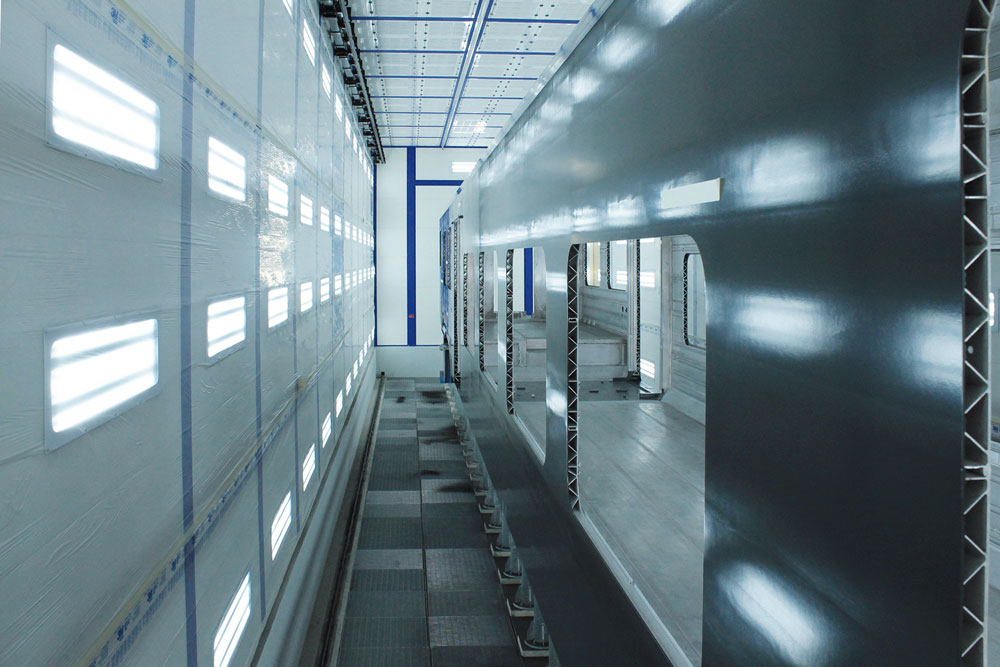 The Eurotherm booth can accommodate carriages up to 27 m in length. © ipcm
The Eurotherm booth can accommodate carriages up to 27 m in length. © ipcmThe livery depends on the customer’s project: “First of all, we look for the best compromise between design and industrial production, especially from a cost and technical feasibility perspective,” Di Donato concludes. “Every customer specifies the conditions in which the train will travel, including altitude, temperature range, rainfall frequency, hours of operation, and kilometres covered. A train travelling through Sicily will obviously not be subjected to the same stress factors (and, therefore, requirements) as one travelling through Trentino. Moreover, not only each train but also each body may require different colours.
Therefore, the possibility of setting different programmes with suitable temperature, humidity, and air speed parameters depending on the necessary process steps is a benefit – also in terms of energy consumption. We will probably mainly use this new booth to finish the trains requiring a more complex coating cycle.”
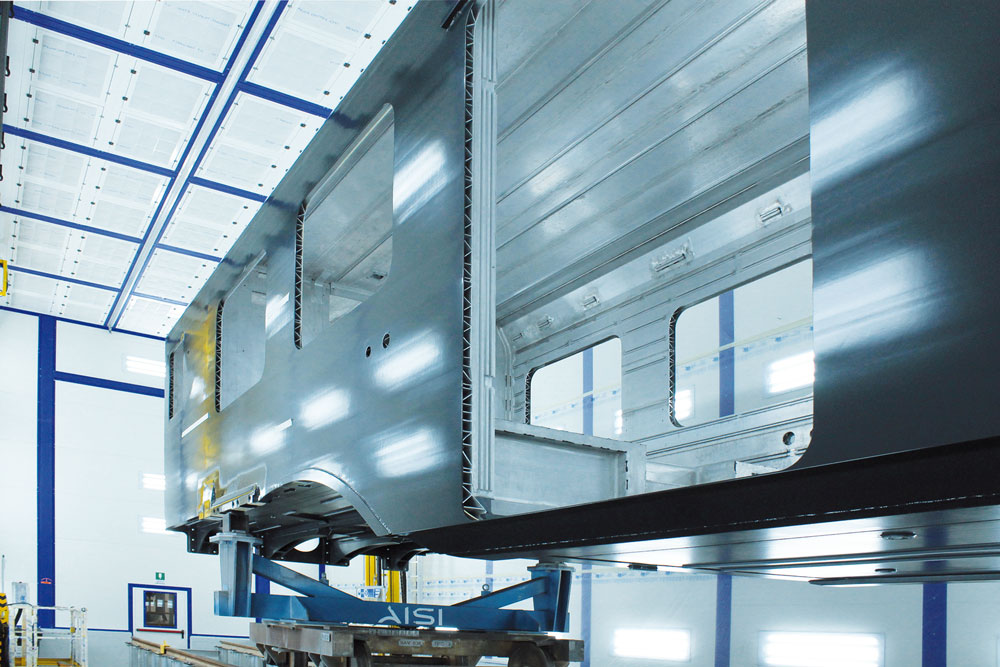 Alstom will probably mainly use this new booth to finish the trains requiring a more complex coating cycle. © ipcm
Alstom will probably mainly use this new booth to finish the trains requiring a more complex coating cycle. © ipcm
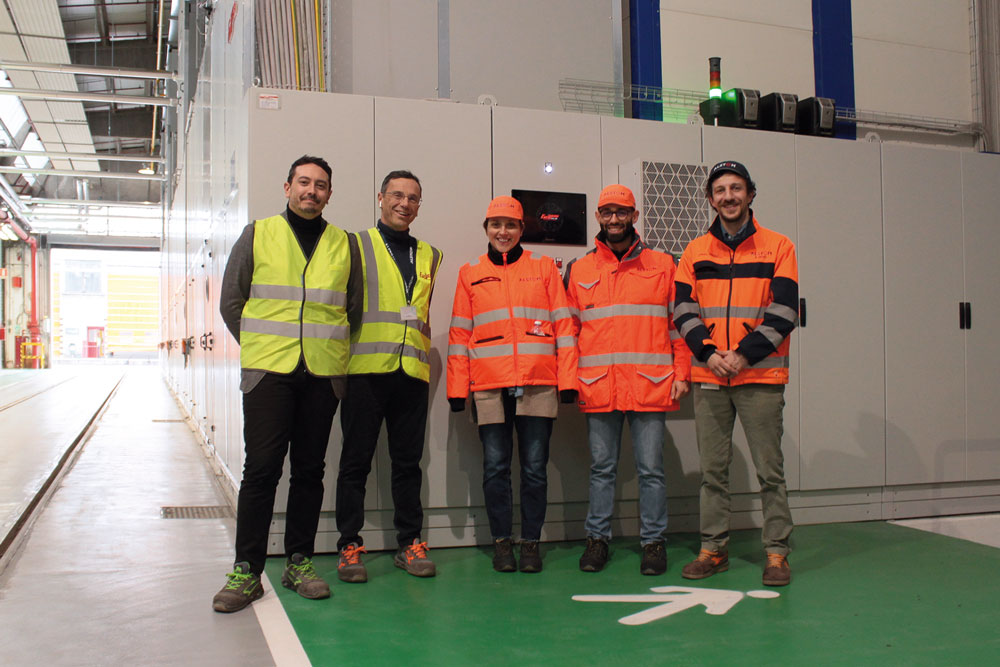 From left to right: Davide Quartana and Paolo Ghiazza from Eurotherm with Federica Lenta, Fabio Di Donato, and Paolo Tesio from Alstom. © ipcm
From left to right: Davide Quartana and Paolo Ghiazza from Eurotherm with Federica Lenta, Fabio Di Donato, and Paolo Tesio from Alstom. © ipcm